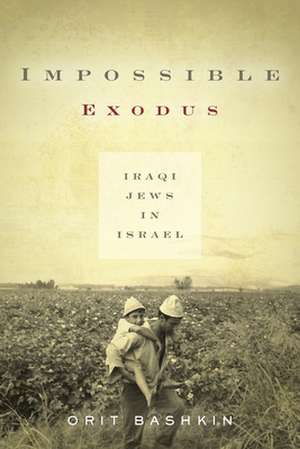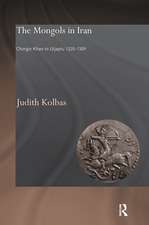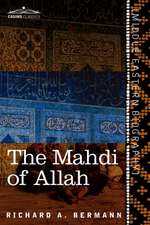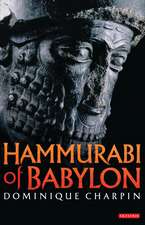Impossible Exodus – Iraqi Jews in Israel: Stanford Studies in Middle Eastern and Islamic Societies and Cultures
Autor Orit Bashkinen Limba Engleză Paperback – 14 aug 2017
| Toate formatele și edițiile | Preț | Express |
|---|---|---|
| Paperback (1) | 200.54 lei 43-57 zile | |
| MK – Stanford University Press – 14 aug 2017 | 200.54 lei 43-57 zile | |
| Hardback (1) | 622.44 lei 43-57 zile | |
| MK – Stanford University Press – 14 aug 2017 | 622.44 lei 43-57 zile |
Din seria Stanford Studies in Middle Eastern and Islamic Societies and Cultures
-
 Preț: 149.68 lei
Preț: 149.68 lei -
 Preț: 162.45 lei
Preț: 162.45 lei - 23%
 Preț: 681.00 lei
Preț: 681.00 lei -
 Preț: 174.37 lei
Preț: 174.37 lei -
 Preț: 202.66 lei
Preț: 202.66 lei -
 Preț: 172.58 lei
Preț: 172.58 lei -
 Preț: 194.70 lei
Preț: 194.70 lei -
 Preț: 203.47 lei
Preț: 203.47 lei -
 Preț: 218.33 lei
Preț: 218.33 lei -
 Preț: 171.47 lei
Preț: 171.47 lei -
 Preț: 146.38 lei
Preț: 146.38 lei -
 Preț: 200.42 lei
Preț: 200.42 lei -
 Preț: 203.00 lei
Preț: 203.00 lei -
 Preț: 201.19 lei
Preț: 201.19 lei -
 Preț: 169.59 lei
Preț: 169.59 lei -
 Preț: 174.96 lei
Preț: 174.96 lei -
 Preț: 201.29 lei
Preț: 201.29 lei -
 Preț: 202.44 lei
Preț: 202.44 lei -
 Preț: 202.19 lei
Preț: 202.19 lei -
 Preț: 194.65 lei
Preț: 194.65 lei -
 Preț: 160.61 lei
Preț: 160.61 lei -
 Preț: 201.08 lei
Preț: 201.08 lei -
 Preț: 202.72 lei
Preț: 202.72 lei -
 Preț: 160.61 lei
Preț: 160.61 lei - 19%
 Preț: 706.64 lei
Preț: 706.64 lei -
 Preț: 214.36 lei
Preț: 214.36 lei -
 Preț: 245.49 lei
Preț: 245.49 lei -
 Preț: 211.68 lei
Preț: 211.68 lei -
 Preț: 247.40 lei
Preț: 247.40 lei - 23%
 Preț: 723.50 lei
Preț: 723.50 lei
Preț: 200.54 lei
Nou
Puncte Express: 301
Preț estimativ în valută:
38.39€ • 41.71$ • 32.26£
38.39€ • 41.71$ • 32.26£
Carte tipărită la comandă
Livrare economică 21 aprilie-05 mai
Preluare comenzi: 021 569.72.76
Specificații
ISBN-13: 9781503602656
ISBN-10: 1503602656
Pagini: 320
Dimensiuni: 152 x 227 x 23 mm
Greutate: 0.43 kg
Editura: MK – Stanford University Press
Seria Stanford Studies in Middle Eastern and Islamic Societies and Cultures
ISBN-10: 1503602656
Pagini: 320
Dimensiuni: 152 x 227 x 23 mm
Greutate: 0.43 kg
Editura: MK – Stanford University Press
Seria Stanford Studies in Middle Eastern and Islamic Societies and Cultures
Cuprins
Contents and Abstracts
Introduction: The Death of an Arab Jew
chapter abstract
This chapter contextualizes the history of Iraqi Jews in Israel within Zionist, Mizrahi, Arab, and global histories. While liberal Zionist discourse emphasizes that Israel before 1967 was an ethical society, attempting to meet the challenges of survival and migration, the Introduction argues that the period from 1948 to 1967 was one of the most horrific eras in Israel's history, when many of its citizens, Jews and Arabs alike, were faced with losing their past homes, livelihoods, and, essentially, everything that they had, amid the indifference of the people living around them. This chapter describes how the state interacted with the Iraqi Jewish community as a project of social engineering, wherein state elites believed that all immigrants, especially Middle Eastern Jews, needed to become Hebrew-speaking, socialist Zionists.1Human Material
chapter abstract
This chapter shows that Iraqi Jews in Israel were migrant-citizens. They had been granted citizenship rights upon their arrival, so that they could vote in general elections and receive welfare benefits and social services. Nonetheless, because the authorities believed they came from a primitive country and were in need of discipline, and because the state did not have resources to attend to their needs, Iraqi Jews were treated as migrant-citizens, namely, as people who should be thankful for the little they got and who were undeserving of full citizenship rights. Iraqi Jews, as well as other groups of migrants to Israel, were classified as "human material," a classification that reflects their dependency on the state and their dehumanization as a result of migration.2Children of Iraq, Children of Israel
chapter abstract
This chapter tells the story of Iraqi-Jewish children in Israel, who grew up in transit camps, in the poor neighborhoods, and on kibbutzim. These children were quicker to adjust to the new living conditions in Israel as their memories of Iraq faded and they learned Hebrew. And yet, these children were the most vulnerable group among the newcomers. They suffered from malnutrition; their parents could not always deal with the pain of displacement and sometimes took out their anger on their children; they attended poor-quality schools; and they often had to leave school to work to support their families. These able and creative children, however, learned how to adjust to the new conditions and challenge and resist the state.3The Only Democracy in the Middle East
chapter abstract
This chapter proposes that the Israeli political system, despite being only partially democratic, offered venues in which Iraqi Jews could voice their complaints. It looks at political parties that had Iraqi-Jewish members who were active in the transit camps and published in the Arabic newspapers of various political parties. The chapter explores Iraqi-Jewish involvement in these organizations and analyzes how parties' leaders conceptualized their relationship to Iraqi Jews. Despite the parties' efforts at outreach, however, none of the political organizations in Israel offered a comprehensive solution to the Iraqi problem. At each and every step of the way, the parties' refusal to recognize the racism of their own members curtailed the possibility of providing a genuine solution.4Elements of Resistance
chapter abstract
Focusing on the issue of political action, this chapter explores elements of resistance to the state's politics. Despite being poor migrants, Iraqi Jews became subversive political actors. From transit camps to the streets of towns, Iraqi Jews resisted the state's housing and employment politics, wrote and sang protest songs, established local committees to negotiate their concerns with the state, showered the state's ministries and administrative bodies with petitions, and destroyed public property. Some were successful in that they managed to secure livelihoods for unemployed individuals, improve their living conditions, or gain employment. Others' protests were less successful in achieving the newcomers' goals, but were effective in raising public awareness of the sufferings of Iraqi Jews.5Israeli Babylonians
chapter abstract
This chapter highlights three identities of the Iraqi-Jewish community that emerged during the 1950s and 1960s in Israel. The first is Iraqi; facing hardships in Israel, Iraq became the Promised Land for many Iraqi Jews. The second was Arab-Jewish; Iraqi Jews continued writing and communicating in Arabic with Arabic-speaking Israeli Jews and Palestinians. Their mastery of Arabic also made them valuable to the state as teachers, translators, and members of the state's security apparatus. The third was Mizrahi, an identity shaped through the struggle against Ashkenazi hegemony, which connected Iraqi Jews to other non-European Jews. The intertwining of these identities created Israelis of Iraqi descent, who were critical of the Ashkenazi establishment, and yet considered themselves Israeli patriots.Conclusion: The Death of Arab Jewishness
chapter abstract
The chapter looks at the history of Iraqi Jews in Israel after 1967. It suggests that contemporary Mizrahi debates have their roots in the 1950s and 1960s, when some Iraqi Jews chose to focus on exclusively the Mizrahi and Iraqi struggle for civil rights, while others, especially communists, sided with the Palestinian struggle. Today, Mizrahi radicals are torn on the issue of the connections, or their absence, between their struggles and those of other oppressed groups in Israel, especially the Palestinians. Looking ahead, it seems very plausible that Israel will become a more segregated society, where Iraqi Jews will still partake of Mizrahi Arab culture as produced in Israel, yet will struggle as Jews in the Jewish state.Notă biografică
Orit Bashkin is Professor of Modern Middle East History at the University of Chicago. She is the author of New Babylonians: A History of Jews in Modern Iraq (Stanford, 2012) and The Other Iraq: Pluralism and Culture in Hashemite Iraq (Stanford, 2008).

















